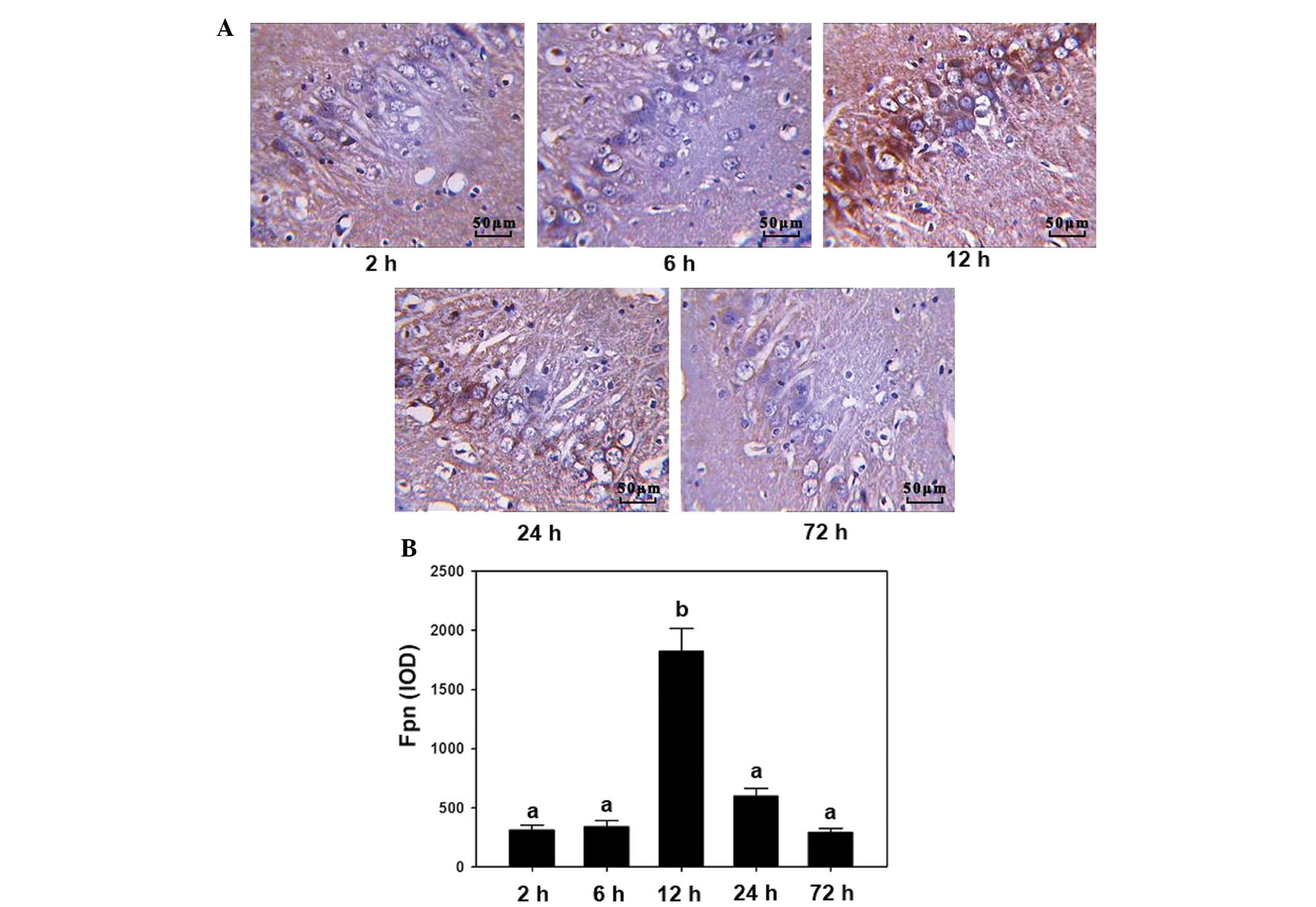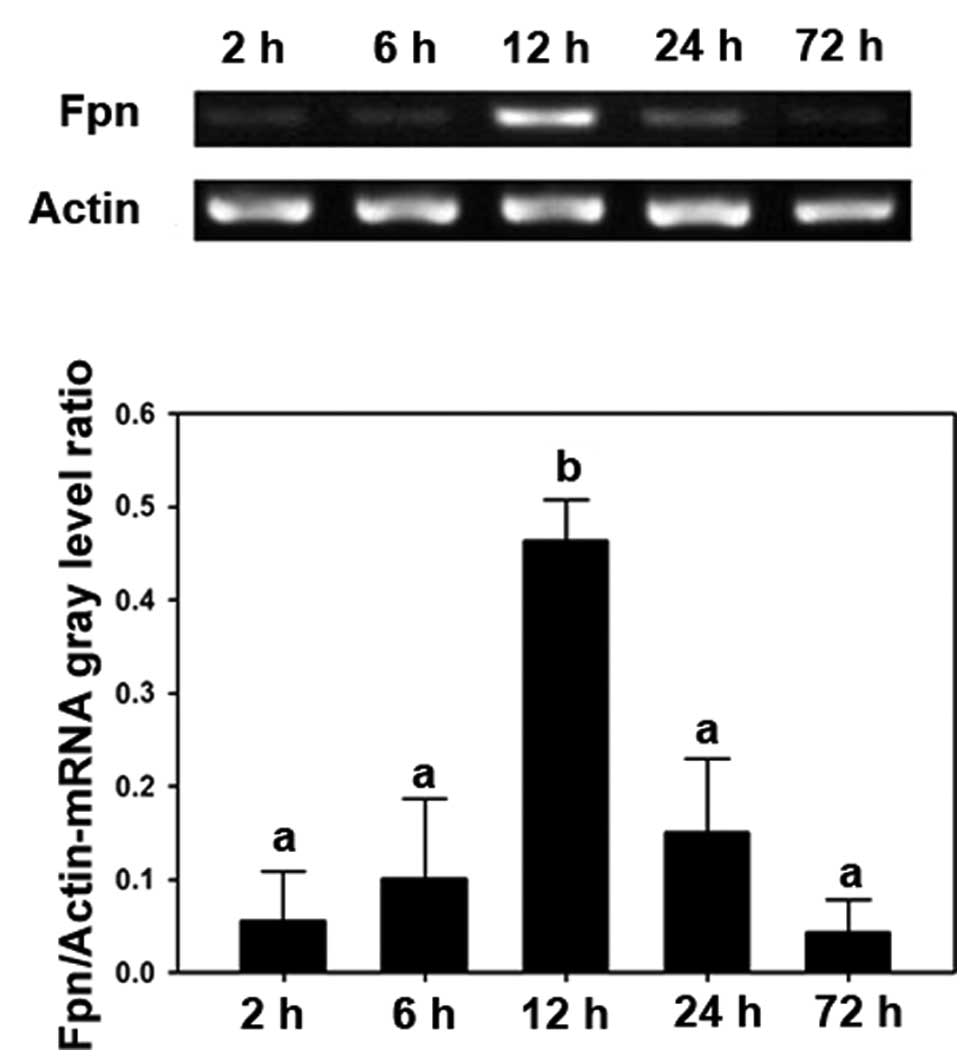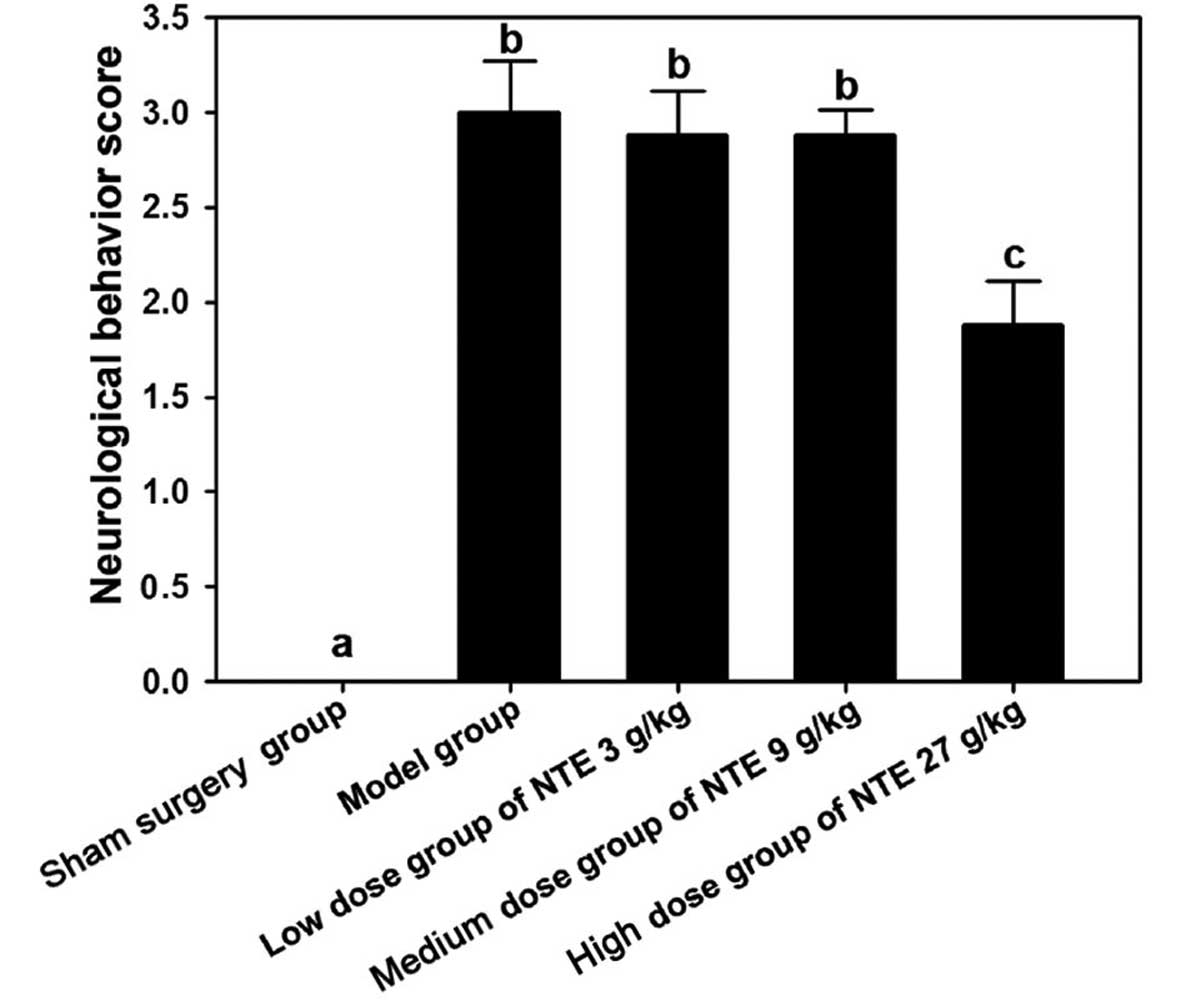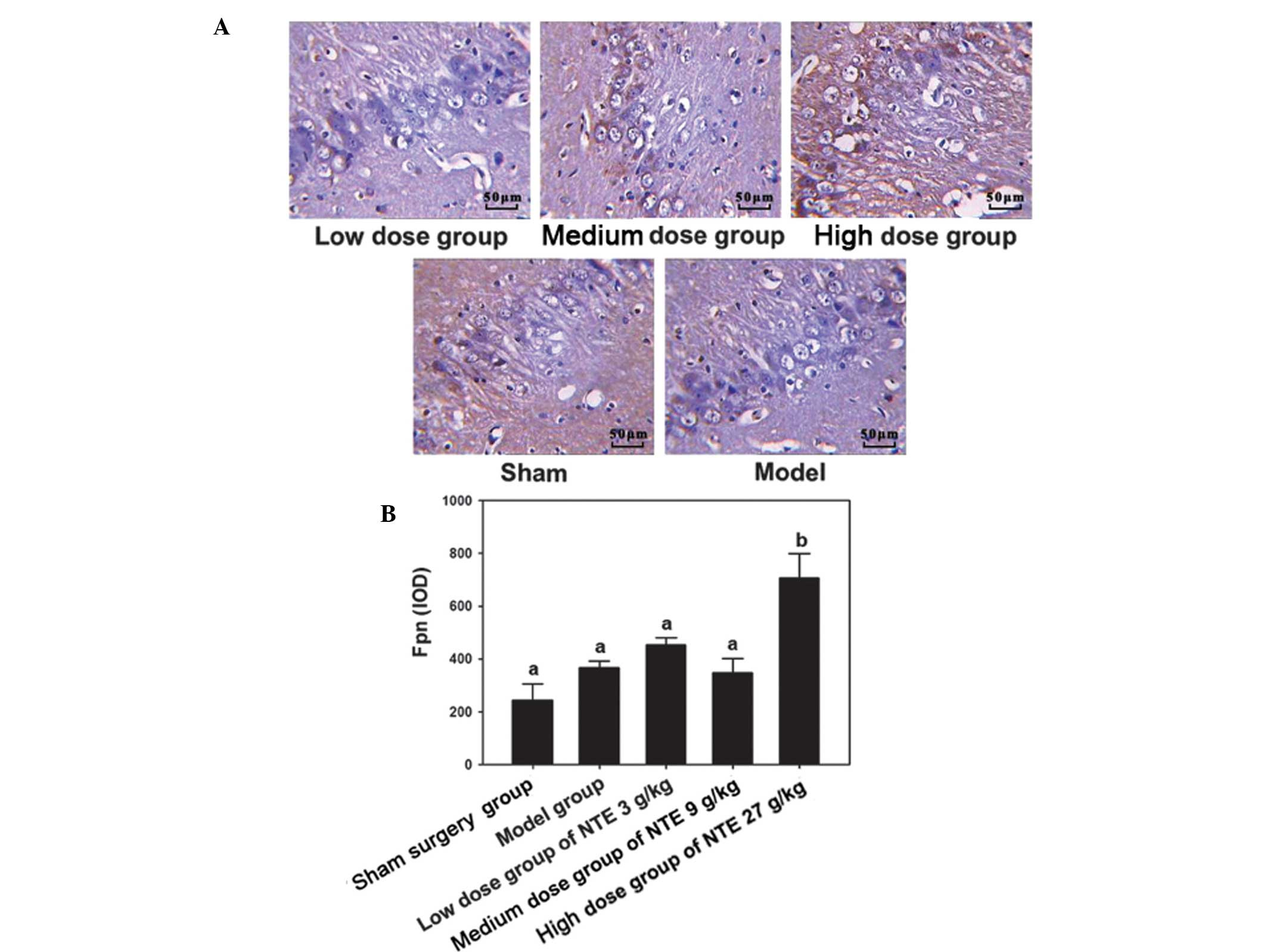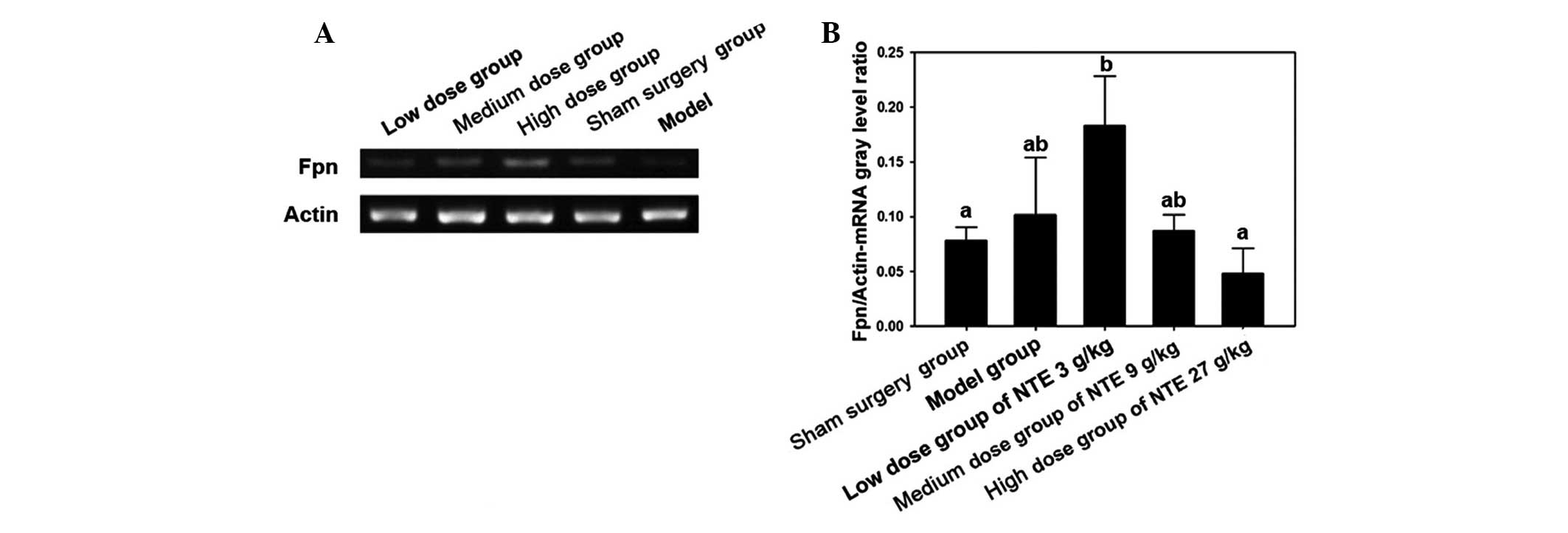Naotaifang extract treatment results in increased ferroportin expression in the hippocampus of rats subjected to cerebral ischemia
Corrigendum in: /10.3892/mmr.2015.4630
- Authors:
- Published online on: February 6, 2015 https://doi.org/10.3892/mmr.2015.3309
- Pages: 4047-4052
-
Copyright: © Liao et al. This is an open access article distributed under the terms of Creative Commons Attribution License [CC BY_NC 3.0].
Abstract
Introduction
Cerebral ischemia is a condition in which there is insufficient blood flow to the brain caused by cerebral vasospasm or an embolism. Previous studies have demonstrated that cerebral ischemia triggers a cascade of pathophysiological events, including glutamate-dependent excitotoxicity, calcium overload, apoptosis, inflammation, free radical formation, nitric oxide production and mitochondrial damage, leading to neuronal cell death (1–5). Through investigating the mechanism underlying cerebral ischemic injury, a theoretical basis for clinical treatment can be proposed and may have far-reaching significance for the prevention and treatment of cerebral ischemia (6).
Iron is an essential trace element in the human body. It is involved in synthesis of the myelin sheath and neurotransmission. Iron is also a type of catalyst, which increases the concentration of reactive oxygen species. The increased production of reactive oxygen species and lipid peroxidation damages neurons in cerebral ischemia (7,8). Cerebral hypoxia leads to iron accumulation and lipid peroxidation in oligodendrocytes in one-day old Wistar rats during development (7). Whether iron accumulation and overload in neurons following cerebral ischemic injury is a novel mechanism requires further investigation.
Iron is composed of heme and non-heme iron in the human body (9). Heme iron is required for the synthesis of heme. Intracellular heme iron can increase heme oxygenase 1 expression and lead to oxidative stress and cell membrane damage (10). Non-heme iron is involved in cell respiration and catalyzing antibody production (11). Serum ferritin is a marker of the body’s non-heme iron store (12). Hepcidin is secreted by the liver and is important in the regulation of iron transport (13). Mutation of the gene BCS1L leads to a mitochondrial disorder and elevated serum ferritin (14). Accumulation of iron is observed in various neurodegenerative disorders, including Alzheimer’s and Parkinson’s disease (15). Excess iron increases ROS expression and activates the caspase protein family, which contributes to apoptosis. The presence of excess iron is therefore recognized as a major risk factor for neurodegenerative diseases (16–17). Previous studies have demonstrated that patients undergoing transfusion therapy are at risk of iron overload with associated tissue damage (15–17). Hyperferritinemia and increased iron stores are associated with the severity of liver damage in non-alcoholic fatty liver disease (18). Iron overload and oxidative stress are involved in the endometriosis-associated inflammatory reaction (19). Certain characteristics of metabolic syndrome are mainly attributed to iron overload (20). As a type of non-heme iron export protein (21–23), ferroportin (Fpn) is abundant in the small intestine and macrophages (24). Previous studies demonstrated that Fpn is also expressed in the hippocampus, cerebral cortex, thalamus, brainstem and cerebellum (25,26). Hepcidin binds to Fpn and promotes its internalization and degradation. Fpn disease, the most common non-HFE hereditary iron-loading disorder, is caused by a loss of iron export function of Fpn resulting in early and preferential iron accumulation in kupffer cells and macrophages (27). Schulz et al found that astrocytes can secrete Fpn to promote remyelination following axonal injury (28). Certain studies have proposed that inflammatory cytokines alter the expression of Fpn resulting in iron accumulation (29). Fpn can therefore respond to intraneural non-heme iron metabolism in cerebral ischemia.
Traditional Chinese medicine has made certain achievements for cerebral ischemia (30–32). Naotaifang extract (NTE) is an extract of a traditional Chinese medicine compound, which improves blood circulation. A previous study demonstrated that NTE is clinically effective for the treatment of cerebral ischemia and the therapeutic mechanism includes anticoagulation and angiogenesis (33).
In order to reveal the dysregulation of intracellular iron and examine the mechanisms underlying cerebral brain, the present study investigated the expression of Fpn in the hippocampal CA2 region cells following induction of cerebral ischemia in rats treated with NTE.
Materials and methods
Animals
A total of 100 healthy adult male Sprague Dawley rats weighing 220–250 g (SPF grade) were provided by the Experimental Animal Center of Hunan University of Chinese Medicine (Changsha, China). The study was approved by the ethics committee of the College of Traditional Chinese Medicine (Changsha, China).
Drugs
NTE consists of astragalus root, chuanxiong and dilong. The extract was acquired by water decoction and alcohol extraction. The active ingredients include astragaloside, ligustrazine and ferulic acid (extracted by pharmaceutical preparation at the Department of Hunan Traditional Chinese Medicine University) mixed with physiological saline to achieve the required concentration.
Experiment one
A total of 50 healthy male Sprague Dawley rats were assigned to the 2 h group (n=10), 6 h group (n=10), 12 h group (n=10), 24 h group (n=10) and 72 h group (n=10) using a random digits table. The rats were used to establish the middle cerebral artery occlusion (MCAO) model.
Experiment two
A total of 50 healthy male Sprague Dawley rats were assigned to either the sham surgery group (n=10) or the surgery group (n=40) using a random digits table. The rats in the surgery group were used to establish the MCAO model. According to the postoperative treatment, the surgery group was divided into the model group (0.9% NaCL), low-dose group (3 g/g NTE), medium dose group (9 g/kg NTE) and high-dose group (27 g/kg NTE). Each group was treated with the corresponding dose through intragastric administration for the following three days after surgery. The animal specimens were collected 72 h after surgery.
Animal modeling
Focal cerebral ischemia was induced by intra-arterial suture occlusion of the right middle cerebral artery (MCA) (34). MCAO was induced by using the intraluminal filament technique. Right common and external carotid arteries were ligated and the internal carotid artery was closed. A fish wire (d=0.28 mm) was advanced through the right internal carotid artery to the origin of the MCA. The sham group was treated identically, with the exception that no intraluminal filament was insert into the MCA. Neurological assessment was used to confirm successful MCAO. Following surgery (35), the cerebral cortex and hippocampus CA2 area exhibited marked neuronal damage on the right side.
Neurobehavioral assessment
Neurobehavioral scores were assessed in each animal following the final treatment at 72 h. A modification of a previous method was used to evaluate the neurological deficit (36). The five categories of motor neurological findings were scored: 0, no observable symptom; 1, contralateral forelimb flexion; 2, contralateral circling; 3, tumble contralateral side; 4, unable to walk, loss of consciousness.
Preparation of tissue slices
All rats were perfused with paraformaldehyde (4%; Sigma-Aldrich, St. Louis, MO, USA) under anesthesia and fixed at different time points (2, 6, 12, 24 and 72 h) following brain ischemia. The brains were then removed and fixed for 1 h, washed with sodium chloride (Sigma-Aldrich), dehydrated with gradient alcohol (Sigma-Aldrich), embedded in paraffin (Sigma-Aldrich) and sectioned in 4 μm thick coronal sections.
Immunohistochemical staining and image analysis
Paraffin sections were incubated at 60°C for 30 min, then dewaxed in xylene (Sigma-Aldrich) and gradient alcohol. Slides were soaked in a solution of 3% H2O2 (Sigma-Aldrich) for 10 min at room temperature to block endogenous peroxidases. Rabbit-anti-rat Fpn monoclonal antibody (1:100; Proteintech, Chicago, IL, USA) was added and incubated for 2 h at 37°C. The sections were washed three times in 0.01 mol/l phosphate-buffered saline (PBS; Sigma-Aldrich) for 5 min. The sections were placed in wet boxes and incubated for 40 min at 37°C with polyclonal biotin-labeled goat anti-rabbit IgG (cat no. PV-600; Proteintech). Subsequently, the sections were washed twice in PBS for 5 min and stained with 3,3′-diaminobenzidine (Sigma-Aldrich). The sections were then observed under an optical microscope (Olympus, Tokyo, Japan). Five sections were randomly selected from each slice. Image analysis was performed using Image Pro Plus 5.0 software (Media Cybernetics, Inc., Rockville, MD, USA) to determine the integral optical density (IOD) of Fpn positive areas in each visual field (magnification, ×400) and an average was calculated.
Expression of Fpn mRNA detected by RT-PCR
At different time points following surgery or 72 h after NTE treatment, 100 mg tissue was extracted from the hippocampus using 1 ml TRIzol (Invitrogen Life Technologies, Carlsbad, CA, USA). RNA was reverse transcribed in a final volume of 10 μl containing 1 μg of total RNA, 1 μl oligo (dT), 10 mM of each deoxyribonucleoside triphosphate (2 μl), 20 units RNasin, 200 units AMV Reverse Transcriptase and 4 μl of 5X Reverse Transcriptase buffer with diethylpyrocarbonate H2O (Reverse-transcription kit, Invitrogen Life Technologies). PCR was performed using 3 μl of synthesized cDNA with 10 μl 2X PCR mix, 1 μl of each primer, 4 μl of PCR buffer and ddH2O to give a total reaction volume of 20 μl. All common components were added to a master mix (Takara, Dalian, China) and then aliquoted. The cycling conditions were as follows: Initial denaturation at 94°C for 4 min followed by 28 cycles of 94°C for 15 sec, 56°C for 30 sec, 72°C for 30 sec and a final extension at 72°C for 5 min. The primers of Fpn were designed (Table I) and Actin was used as a loading control.
Statistical analysis
All data are expressed as the mean ± standard deviation and were statistically analyzed using SPSS 11.0 software (SPSS, Inc., Chicago, IL, USA). The two-sample t-test was used for comparison among groups. P<0.05 was considered to indicate a statistically significant difference.
Results
Experiment one
The expression of Fpn was detected using immunohistochemistry and RT-PCR in the hippocampal CA2 region, at different time points following induction of cerebral ischemia. The results from the immunohistochemistry experiments showed that the darkest staining was observed at 12 h while the changes were less marked in the 2, 6, 24 and 72 h groups (Fig. 1A). RT-PCR demonstrated similar results; after 12 h treatment, the expression of Fpn was significantly increased compared with the time points (P<0.05; Fig. 1B). The RT-PCR analysis also supported the results that only the 12 h treatment group demonstrated a significant increase among all the groups (P<0.05; Fig. 2).
Experiment two
Compared with the sham surgery group, the surgery group exhibited a higher neurological behavior score (P<0.05) and compared with the model group, the high-dose group exhibited a lower neurological behavior score (P<0.05; Fig. 3).
The immunohistochemical results suggested that following treatment with 3 g/kg NTE, the expression of Fpn increased significantly compared with the other treatment doses (P<0.05). However, no significant changes were observed among other groups (P>0.05; Fig. 4). The RT-PCR analysis also supported the results that only the 12 h treatment group demonstrated a significant increase among all the groups (P<0.05; Fig. 5).
Discussion
Fpn is a type of non-heme iron exporter protein in the cell membrane. It can be internalized and degraded by binding to hepcidin. The present study demonstrated that expression of Fpn in the hippocampal CA2 region was increased following occlusion of the right MCA, reaching a peak at 12 h, and then decreasing to a minimum at 72 h. The present study demonstrated that intraneural iron metabolism is imbalanced in cerebral ischemia. In addition, the results demonstrate that cellular iron accumulation promotes the expression of Fpn. Iron metabolism imbalance can promote cellular iron efflux. Intracellular iron accumulation may promote the expression of Fpn by a variety of signaling pathways (37). In the present study, following 12 h, intracellular iron efflux increased due to iron overload, however, compensatory adjustment of neurons was limited. After 12 h, the expression of Fpn reduced and iron outflow decreased. The accumulation of iron leads to the increased production of reactive oxygen species and lipid peroxidation, which may damage neurons (38). Thus, it was proposed that if a drug intervention can maintain high Fpn expression following cerebral ischemia, then it may regulate iron metabolism to reduce the damaging effect.
NTE is a traditional Chinese extract that promotes the recovery of neurological function and improvement of blood circulation (39). NTE consists of astragalus root, chuanxiong and dilong. Previous studies have demonstrated that Astragalus may reduce the expression of HIF-1a (hypoxia inducible factor-1a), which protects hippocampal neurons following ischemic brain damage (40). Astragalus may reduce apoptosis in hippocampal neurons through reducing the cellular malondialdehyde and nitric oxide content, thus increasing the activity of superoxide dismutase (41). The active ingredients of chuanxiong contain ligustrazine and ferulic acid (42). Animal experiments have demonstrated that ligustrazine may stimulate neurogenesis following focal cerebral ischemia (43). Previous studies have indicated that ferulic acid may enhance the expression of GABAB1 receptors at 3 h of reperfusion and thereby provide neuroprotection (44). All components in NTE work together in order to promote blood circulation and improve the recovery of neurological function following cerebral ischemia.
Previous studies have demonstrated that Astragalus polysaccharide can prevent neuronal apoptosis following cerebral ischemia (32). Ferulic acid has a neuroprotective effect by promoting the formation of nitric oxide in rat cerebral ischemia (32). Previous studies have verified that NTE is clinically effective for the treatment of cerebral ischemia (45,46). The therapeutic mechanism includes anticoagulation and angiogenesis. Experiment one demonstrated that Fpn expression was reduced to the lowest point 72 h after cerebral ischemia, therefore, in experiment two the animal specimens were produced at the same time point following NTE intervention. The present study demonstrated that a high dose of NTE can increase the expression of Fpn in the hippocampal CA2 region. The traditional Chinese medicine NTE can enhance the expression of Fpn, increase iron excretion in neurons and reduce neuronal oxidative damage caused by iron accumulation. Therefore, the present study concluded that NTE can protect the neurons in the hippocampal CA2 region by increasing the expression of Fpn and promoting neuronal iron efflux in cerebral ischemia.
Acknowledgments
This study was supported by the National Natural Science Foundation of China (grant nos. 81303078 and 81202794), the Natural Science Foundation of Hunan Province (grant no. 12JJ6076), the Foundation of Hunan Provincial Administration of Traditional Chinese Medicine (grant no. 201240), the Foundation of Education Bureau of Hunan Province for Young Teachers (grant no. 11B090), the Key Laboratory of Hunan Province for Integrated Traditional Chinese and Western Medicine on Prevention and Treatment of Cardio-Cerebral Diseases, the Key Laboratory of Colleges and Universities in Hunan Province for Cytobiology and Molecular Biotechnology, Hunan University of Chinese Medicine Aid program for Science and Technology and the Innovative Research Team in Higher Educational Institutions of Hunan Province.
References
|
Chu XP and Xiong ZG: Physiological and pathological functions of acid-sensing ion channels in the central nervous system. Curr Drug Targets. 13:263–271. 2012. View Article : Google Scholar : | |
|
Xu M and Zhang HL: Death and survival of neuronal and astrocytic cells in ischemic brain injury: a role of autophagy. Acta Pharmacol Sin. 32:1089–1099. 2011. View Article : Google Scholar : PubMed/NCBI | |
|
Xu F, Gu JH and Qin ZH: Neuronal autophagy in cerebral ischemia. Neurosci Bull. 28:658–666. 2012. View Article : Google Scholar : PubMed/NCBI | |
|
Olmez I and Ozyurt H: Reactive oxygen species and ischemic cerebrovascular disease. Neurochem Int. 60:208–212. 2012. View Article : Google Scholar | |
|
Belousov AB: Novel model for the mechanisms of glutamate-dependent excitotoxicity: Role of neuronal gap junctions. Brain Res. 1487:123–130. 2012. View Article : Google Scholar : PubMed/NCBI | |
|
Giuliani D, Minutoli L, Ottani A, et al: Melanocortins as potential therapeutic agents in severe hypoxic conditions. Front Neuroendocrinol. 33:179–193. 2012. View Article : Google Scholar : PubMed/NCBI | |
|
Rathnasamy G, Ling EA and Kaur C: Iron and iron regulatory proteins in amoeboid microglial cells are linked to oligodendrocyte death in hypoxic neonatal rat periventricular white matter through production of proinflammatory cytokines and reactive oxygen/nitrogen species. J Neurosci. 31:17982–17995. 2011. View Article : Google Scholar : PubMed/NCBI | |
|
Gebril OH, Simpson JE, Kirby J, Brayne C and Ince PG: Brain iron dysregulation and the risk of ageing white matter lesions. Neuromolecular Med. 13:289–299. 2011. View Article : Google Scholar : PubMed/NCBI | |
|
Muñoz P and Humeres A: Iron deficiency on neuronal function. Biometals. 25:825–835. 2012. View Article : Google Scholar : PubMed/NCBI | |
|
Khan AA and Quigley JG: Heme and FLVCR-related transporter families SLC48 and SLC49. Mol Aspects Med. 34:669–682. 2013. View Article : Google Scholar : PubMed/NCBI | |
|
Garrick MD and Garrick LM: Cellular iron transport. Biochim Biophys Acta. 1790:309–325. 2009. View Article : Google Scholar : PubMed/NCBI | |
|
Ferraro S, Mozzi R and Panteghini M: Revaluating serum ferritin as a marker of body iron stores in the traceability era. Clin Chem Lab Med. 50:1911–1916. 2012. View Article : Google Scholar : PubMed/NCBI | |
|
Vermeulen E and Vermeersch P: Hepcidin as a biomarker for the diagnosis of iron metabolism disorders: a review. Acta Clin Belg. 67:190–197. 2012.PubMed/NCBI | |
|
Fellman V: GRACILE syndrome-a severe neonatal mitochondrial disorder. Duodecim. 128:1560–1567. 2012. | |
|
Chu WC, Au WY and Lam WW: MRI of cardiac iron overload. J Magn Reson Imaging. 36:1052–1059. 2012. View Article : Google Scholar : PubMed/NCBI | |
|
Shander A, Berth U, Betta J and Javidroozi M: Iron overload and toxicity: implications for anesthesiologists. J Clin Anesth. 24:419–425. 2012. View Article : Google Scholar : PubMed/NCBI | |
|
Elborai Y, Uwumugambi A and Lehmann L: Hematopoietic stem cell transplantation for thalassemia. Immunotherapy. 4:947–956. 2012. View Article : Google Scholar : PubMed/NCBI | |
|
Valenti L, Dongiovanni P and Fargion S: Diagnostic and therapeutic implications of the association between ferritin level and severity of nonalcoholic fatty liver disease. World J Gastroenterol. 18:3782–3786. 2012. View Article : Google Scholar : PubMed/NCBI | |
|
González-Ramos R, Defrère S and Devoto L: Nuclear factor-kappaB: a main regulator of inflammation and cell survival in endometriosis pathophysiology. Fertil Steril. 98:520–528. 2012. View Article : Google Scholar | |
|
Annaloro C, Airaghi L, Saporiti G, Onida F, Cortelezzi A and Deliliers GL: Metabolic syndrome in patients with hematological diseases. Expert Rev Hematol. 5:439–458. 2012. View Article : Google Scholar : PubMed/NCBI | |
|
Theil EC: Iron homeostasis and nutritional iron deficiency. J Nutr. 141:724S–728S. 2011. View Article : Google Scholar : PubMed/NCBI | |
|
Chen J and Enns CA: Hereditary hemochromatosis and transferrin receptor 2. Biochim Biophys Acta. 1820:256–263. 2012. View Article : Google Scholar | |
|
Graham RM, Chua AC, Herbison CE, Olynyk JK and Trinder D: Liver iron transport. World J Gastroenterol. 13:4725–4736. 2007.PubMed/NCBI | |
|
Kasvosve I: Effect of ferroportin polymorphism on iron homeostasis and infection. Clin Chim Acta. 416:20–25. 2012. View Article : Google Scholar : PubMed/NCBI | |
|
Zheng W and Monnot AD: Regulation of brain iron and copper homeostasis by brain barrier systems: implication in neurodegenerative diseases. Pharmacol Ther. 133:177–188. 2012. View Article : Google Scholar : | |
|
Boserup MW, Lichota J, Haile D and Moos T: Heterogenous distribution of ferroportin-containing neurons in mouse brain. Biometals. 24:357–375. 2011. View Article : Google Scholar : PubMed/NCBI | |
|
Pietrangelo A, Caleffi A and Corradini E: Non-HFE hepatic iron overload. Semin Liver Dis. 31:302–318. 2011. View Article : Google Scholar : PubMed/NCBI | |
|
Schulz K, Kroner A and David S: Iron efflux from astrocytes plays a role in remyelination. J Neurosci. 32:4841–4847. 2012. View Article : Google Scholar : PubMed/NCBI | |
|
Urrutia P, Aguirre P, Esparza A, et al: Inflammation alters the expression of DMT1, FPN1 and hepcidin, and it causes iron accumulation in central nervous system cells. J Neurochem. 126:541–549. 2013. View Article : Google Scholar : PubMed/NCBI | |
|
Wang HW, Liou KT, Wang YH, et al: Deciphering the neuroprotective mechanisms of Bu-yang Huan-wu decoction by an integrative neurofunctional and genomic approach in ischemic stroke mice. J Ethnopharmacol. 138:22–33. 2011. View Article : Google Scholar : PubMed/NCBI | |
|
Loh KP, Qi J, Tan BK, Liu XH, Wei BG and Zhu YZ: Leonurine protects middle cerebral artery occluded rats through antioxidant effect and regulation of mitochondrial function. Stroke. 41:2661–2668. 2010. View Article : Google Scholar : PubMed/NCBI | |
|
Koh PO: Ferulic acid modulates nitric oxide synthase expression in focal cerebral ischemia. Lab Anim Res. 28:273–278. 2012. View Article : Google Scholar | |
|
Yunhe H, Jinwen G and Zhanying C: Effect of Naotaifang on TXB 2, 6-Keto-PGF 1α in plasma and TNF-α in serum of patients with cerebral infarction with deficiency of Qi and blood stasis. Chinese Journal of Information on Traditional Chinese Medicine. 4:16–17. 2002. | |
|
Garcia JH: A reliable method to occlude a middle cerebral in wistar rats. Stroke. 24:14231993. | |
|
González-Delgado M and Bogousslavsky J: Superficial middle cerebral artery territory infarction. Front Neurol Neurosci. 30:111–114. 2012. View Article : Google Scholar : PubMed/NCBI | |
|
Longa EZ, Weinstein PR, Carlson S and Cummins R: Reversible middle cerebral artery occlusion without craniectomy in rats. Stroke. 20:84–91. 1989. View Article : Google Scholar : PubMed/NCBI | |
|
Eisenstein RS: Iron regulatory proteins and the molecular control of mammalian iron metabolism. Annu Rev Nutr. 20:627–662. 2000. View Article : Google Scholar : PubMed/NCBI | |
|
Bandyopadhyay U, Das D and Banerjee RK: Reactive oxygen species: oxidative damage and pathogenesis. Curr Sci. 77:658–666. 1999. | |
|
Jinwen G, Song C and Huibin Z: Effect of naotaifang extract on functional changes of coagulation and fibrinolysis of human umbilical veins endothelial cell induced by recombined human tumor necrosis factor alpha. J Trad Chin Med U Hun. 6:4–6. 2005. | |
|
Zhang Q, Gao WY, Zhang Y, et al: Protective effects of astragalus extract against intermittent hypoxia-induced hippocampal neurons impairment in rats. Chin Med J (Engl). 126:1551–1554. 2013. | |
|
Yin YY, Zhu FF and Wu GC: Protective effect of astragalosides on anoxia/reoxygenation injury of hippocampal neuron. Zhongguo Zhong Xi Yi Jie He Za Zhi. 30:1173–1177. 2010.In Chinese. | |
|
Li SL, Chan SS, Lin G, et al: Simultaneous analysis of seventeen chemical ingredients of Ligusticum chuanxiong by online high performance liquid chromatography-diode array detector-mass spectrometry. Planta Med. 69:445–451. 2003. View Article : Google Scholar : PubMed/NCBI | |
|
Qiu F, Liu Y, Zhang PB, et al: Effects of ligustrazine on hippocampal dentate gyrus cell proliferation after focal cerebral ischemia in adult rats. Nan Fang Yi Ke Da Xue Xue Bao. 26:1400–1403. 2006.PubMed/NCBI | |
|
Cheng CY, Su SY, Tang NY, et al: Ferulic acid inhibits nitric oxide-induced apoptosis by enhancing GABA(Bl) receptor expression in transient focal cerebral ischemia in rats. Acta Pharmacol Sin. 31:889–899. 2010. View Article : Google Scholar : PubMed/NCBI | |
|
He YH, Hao XY, Ge JW, et al: Clinical studies on naotaifang in treating patients with cerebral infarction with deficiency of qi and blood stasis in TCM. J Emerg Trad Chin Med. 10:319–320. 2001. | |
|
Zhu HB, Chen Y, Tan H and Ge JW: Effects of Naotai recipe extracts on cerebral CD34 expression in rats with focal cerebral ischemia. Trad Chin Drug Res Clin Pharma. 22:141–144. 2011. |



